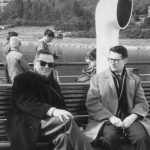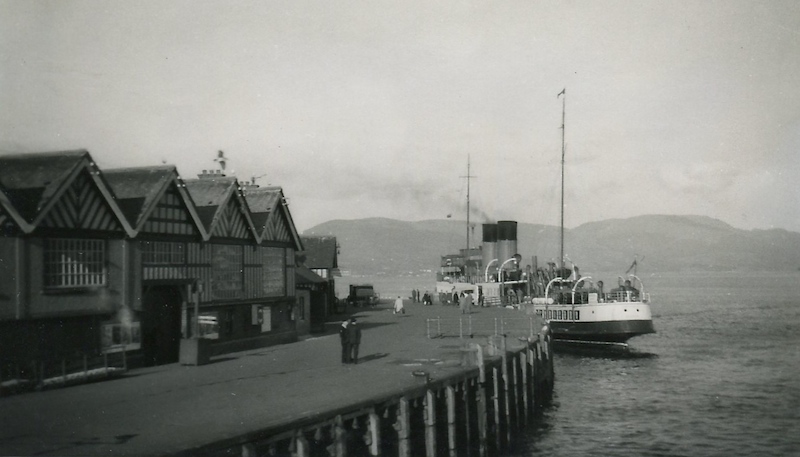
King George V at Gourock in October 1960, when she was roused from winter lay-up to undertake the Tarbert mail service. Copyright Fraser G. MacHaffie
Fraser MacHaffie remembers winter on the Clyde more than 50 years ago.
Reading Gordon Law’s interesting accounts of his winter sailings pushed me to reflect on winter cruising opportunities on the Clyde when I first began noticing the steamers in the 1960s. The summers presented a challenge of choosing among competing goods, but winters were different.
On weekdays Glen Sannox did two round trips between Fairlie and Brodick, and the morning outward sailing from Fairlie allowed ample time for walking to Lamlash or further and returning by service bus for the afternoon return sailing to Fairlie.
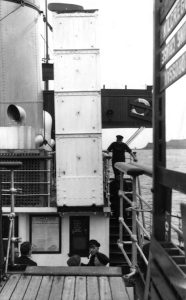
Rare occurence: the upper deck bridges of Caledonia were raised on 18 October 1959 at Millport to accommodate a caravan (see below). The seaman facing the camera is Joe O’Brian, father of Waverley’s former captain, Andy O’Brian. Copyright Fraser G. MacHaffie
There was also the MacBrayne mail boat from Gourock through the Kyles to Tarbert. The constant shuddering of Lochfyne took a bit of getting used to and the relief steamer Lochnevis was always welcomed by enthusiasts. The October 1960 sinking of Lochiel in Loch Tarbert brought King George V on to the Clyde run for over six weeks while Lochfyne moved to Oban for the Tobermory run and Lochearn provided a link between Oban and Port Askaig (though I believe Claymore took the first run).
My favourite was the Sunday Millport run from Gourock. The first half of the winter was covered by Caledonia and the latter half by Talisman. After Gourock (1030/1835) calls were made at Dunoon (1055/1815), Innellan (1115/1745), Rothesay (1150/1715), Fairlie (1245/1620), and Millport Old Pier (1315/1600). For much of the winter it was the evening run up from Rothesay that justified the use of a steamer larger than a ‘Maid’.
Car owners down for a weekend on Cumbrae would leave their vehicles at Largs on the Friday or Saturday, and so the Sunday afternoon return sailing, calling only at Fairlie, caused much inconvenience. But the CSP was still indifferent to those who chose not to travel by train, and was really answerable to no one (as Graeme Hogg showed in his article ‘Decade of decisions deferred’ in the 2017 edition of Clyde Steamers).
In October 1962 railway works at Greenock required a temporary extension to the sailing with Caledonia starting at Craigendoran (1000) – much to the delight of North Bank enthusiasts — and finishing there in the evening, with connections from and to Glasgow. This made the sailing doubly unusual. It was probably the first regular service on winter Sundays from the North Bank, and it was the first time for many years that a through sailing was available from Craigendoran to Millport’s Old Pier.
I had many good conversations with the late Geoffrey Grimshaw, for whom the Millport sailing was his regular winter Sunday routine. During the time ashore, a favourite spot was a sheltered bench overlooking the West Bay. We always ate well on Caledonia regardless of the season.
On the afternoon of 10 November 1963, Caledonia found herself bottled in by weather at the Old Pier and had to remain overnight. Conditions had eased a trifle by the next morning and Caledonia took the first run of the day out of Millport. Passing between the Eileans and the Cumbrae shore, the port wheel either failed or hit a submerged rock – the engineers claimed the latter and the navigators the former – and Caledonia was disabled.
Leven on the newspaper/mail run from Fairlie took off Caledonia’s passengers and Glen Sannox, inward bound from Brodick, pulled the paddler out of the rock-infested bay. Later that day she was towed to Greenock. Geoffrey Grimshaw spent the night in the Assistant Pursers’ cabin.
The only other ship sailing on Sundays was an ABC giving three round trips Rothesay-Dunoon-Gourock, and one round trip Gourock-Dunoon.
If you could penetrate the high security fence erected around the CSP Sailings Instructions, trips on the Holy Loch run on a paddler were possible in winter when the ‘Maid’ was required for tender duties. (The embarkation doors of the trans-Atlantic liners favoured the upper landing deck of the ‘Maids’.) I have, on occasion, been the only passenger sailing at 0920 from Gourock to Kilmun on Caledonia, a ship capable of carrying 1,766 passengers on her summer Class V certificate.
This is the first article of an occasional series devoted to ‘winter cruising’.
Fraser MacHaffie, a former CRSC Honorary Treasurer, is the author of ‘The Short Sea Route’ (Stephenson, 1975) and ‘Scotia and Caledonia’ (CRSC, 2013): the latter can be purchased from the Club bookshop by clicking here.
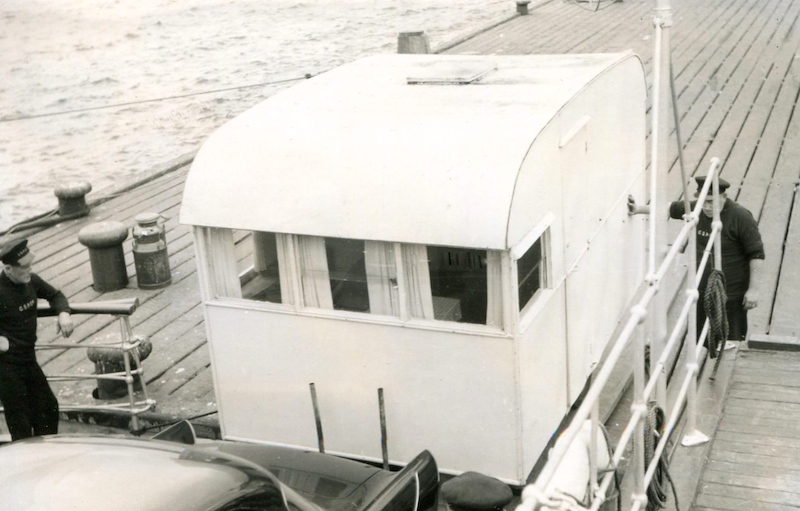
A caravan being loaded onto Caledonia at Millport on 18 October 1959. Copyright CRSC/Geoffrey Grimshaw Collection
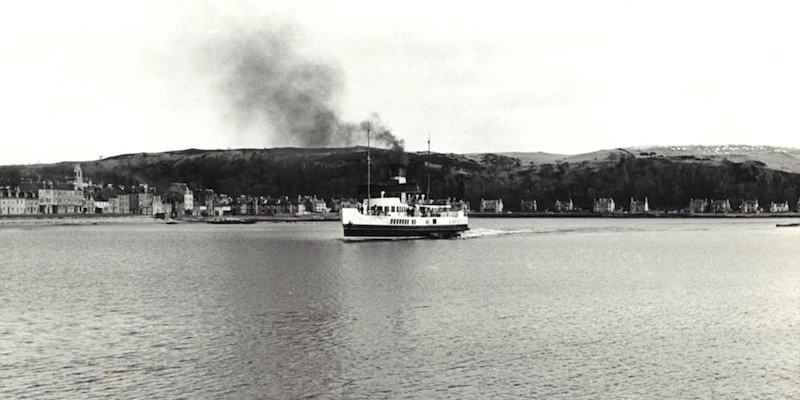
Caledonia approaching Millport’s Old Pier c1954 through the channel inside the Eileans — a passage occasionally chosen in winter by Clyde steamer captains when wind and tide were agreeable. Copyright CRSC/The Estate of Walter and Effie Kerr
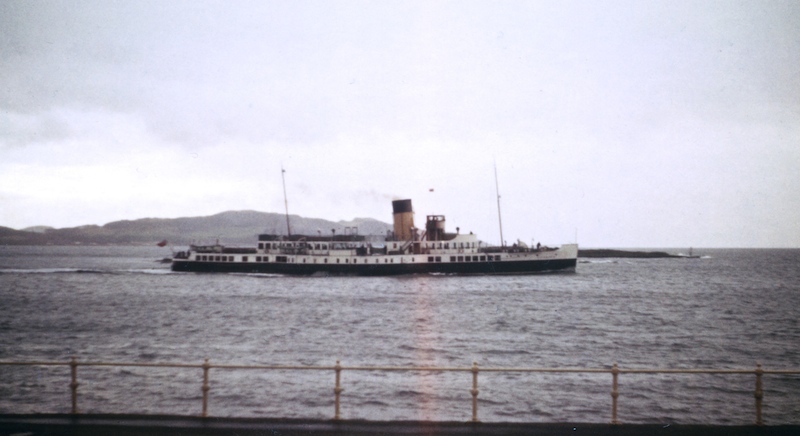
Another rare shot of Caledonia passing inside the Eileans at high tide in the mid 1950s, this time viewed from the Millport prom in front of the Garrison. Copyright Ian Duncan
Catch up with all CRSC’s news and reports by clicking here.












